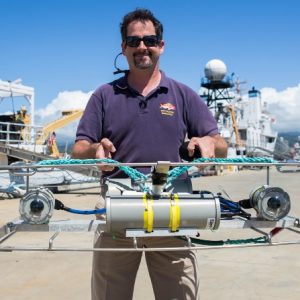2024 – 2026 Cohort
Applications for MARC@UHM cohort 2024 – 2026 are now open!


Your project title
Project description after discussion with your mentor.2023 – 2025 Cohort



Effects of Artificial Illumination on Behavior of Hawaiʻi Deep 7 Bottomfish Species
Hawaii’s Deep 7 Bottomfish stock is both economically and culturally important. NOAA conducts annual population surveys incorporating underwater cameras, but these are light-limited beyond 200m depth, missing part of the Deep 7’s habitat range (75-400m). NOAA is testing artificial illumination but needs to ensure lights don’t bias fish behavior. Prior studies indicate lights can affect fish behavior, but none focused on the Deep 7 species. This project investigates Deep 7 behavior in response to various light colors. Successful integration of lights allowing deeper surveys is critical for fully expanding camera operations to include the Deep 7’s entire habitat.

Screening of Hawaiian marine extracts for antiviral activity against Dengue
Dengue virus (DENV) is a significant public health concern because it can lead to potentially fatal symptoms including hemorrhagic fever in children. DENV vaccines are still in clinical trials and there are no effective anti-flavivirus therapeutics to quickly clear the virus. However, natural products, including marine extracts (ME), have medicinal properties against many diseases. In collaboration with Dr. Horgen from HPU, we will screen ~500 ME from Hawaii for anti-dengue activity. Vero cells will be infected with GFP-tagged DENV-2 in the presence of ME and visualized using the CTL plate reader to identify ME with strong antiviral activity. These ME will be validated using plaque assay.

TBA
TBD


High Throughput Organoid Screening using Centrifugal Force on a 3D-Printed Microfluidic Chip
Organoids, which mimic organs in gene expression, protein expression, tissue architecture, and cell interactions, are pivotal in drug development, personalized medicine, and disease modeling. However, their widespread use is hindered by the cost and labor of organoid testing and screening due to the needed equipment such as automated liquid handlers and robots for sample preparation, screening, and analysis. The principle idea can be extended to the lab-on-a-chip to develop an apparatus with similar performance. Therefore, this project aims to create an affordable, reproducible 3D-printed microfluidic chip for organoid HTS. A high precision 3D printer will be used to create small, precise microfluidic channels and flow control valves. Additionally, the chip will utilize centrifugal forces and flow control valves, eliminating the need for external sources such as syringe pumps and pressure-driven flow controllers.

Contributing towards the total synthesis of Aleutianamine
Pancreatic cancer currently has a survival rate of less than 9%, necessitating the development of effective therapeutic treatments. Aleutianamine, a marine-derived natural product, belongs to a family of pyrroloiminoquinone alkaloids that have recently shown promising activity against PANC-1 pancreatic cancer cell lines. It is in our interest to develop an efficient and scalable synthesis to allow for further biological studies. Highlights of this novel route include an early-stage cyclization to form the tricyclic core, a structural motif shared among these promising anti-cancer compounds.

Network Sampling
In this research project, I am aiming to investigate graphical models that preserve the maximum likelihood threshold, defined as the minimum number of data points ensuring the existence of a maximum likelihood estimate for a given graphical model. By employing combinatorics and algebraic statistics, I am seeking to optimize model parameters to fit relatively small datasets with fewer observations than random variables. I will analyze sets of simple moves such as edge swapping, removal, and addition in graphs with six vertices to understand their impact on the maximum likelihood threshold. This study holds implications for network sampling, model selection, and statistical inference, especially in biology applications like gene expression and microbiome data analysis.

Developing an Additive Manufacturing Process for Fabricating Wearable Biochemical Sensors
Additive manufacturing, commonly known as 3D printing, has emerged as a form of transformative technology and has the potential to play a crucial role in the contemporary healthcare sector. My project’s primary objective involves integrating a variety of additive manufacturing techniques to create wearable biochemical sensors. The VolteraNova, an additive manufacturing device capable of printing flexible electronic components, will be utilized to create electrochemical sensors by employing conductive carbon and silver inks. These electrochemical sensors, which operate based on electrochemical reactions occurring on the sensing interface of the component, will be designed to detect a wide variety of chemical compounds in samples. Additionally, prototypes of wearable devices, such as sweat biosensors or electrochemical rings, that can easily interface with a user’s everyday life will be designed and 3D printed using FDM and SLA printers. The electrochemical sensors will then be integrated together with the wearable devices to enable real-time monitoring and assessment of various health parameters. The subsequent devices will be further tested for the production of wearable electronics.2022 – 2024 Cohort


Immobilizing Antibodies on a Solid Surface and Visualizing with Surface Plasmon Resonance
There were 1.3 million people who acquired HIV in 2022. This can be directly impacted by creating an effective vaccine that will help prevent the spread of HIV. The biggest barrier to an HIV vaccine is the vast phenotypic diversity in the viral spike protein, gp120. VRC01 is a prototypical broadly neutralizing antibody (bnAb) capable of high-affinity binding to gp120 from a wide range of HIV isolates. The MacPherson group has previously developed novel immunogens designed to have a high affinity for VRC01. The overall objective of this project is to use Surface Plasmon Resonance to determine the binding kinetics of these immunogens for VRC01-type antibodies. To this end, the Strep-tag system will be used to anchor the VRC01 antibody to the SPR sensor. This project will allow us to better understand and assess the binding kinetics of our immunogen to VRC01-type antibodies.

The role of Phosphoglucomutase 5 in embryonic development
Phosphoglucomutase 5 (PGM5) is an enigmatic member of the PGM family of glycolytic enzymes. Studies in muscle tissue suggest PGM5 serves as a structural protein promoting cell-cell adhesion in association with cytoskeletal proteins, which distinguishes PGM5 from the other four PGM proteins that clearly function as enzymes. While some members of the PGM family have been shown to be essential for development using mouse models, it has not been determined whether this is the case for PGM5. This project will determine whether PGM5 deficiency in mice is embryonic lethal and, if so, at what stage of embryonic development is disrupted.

Identification of Biomarkers for Colorectal Cancer
Colorectal Cancer (CRC) is the fourth most common cancer and second most common cause of cancer-related death in the United States. Furthermore, its incidence and mortality rates demonstrate disparities across different racial/ethnic populations. This research project aims to identify and analyze biomarkers associated with CRC by analyzing publicly available datasets from sources like the Database of Genotypes and Phenotypes (dbGaP) and the International Cancer Genome Consortium (ICGC). It will focus on the unique context of multiethnic health disparities in CRC. Whole genome or exome sequencing data, as well as metabolomics data, will be used to comprehensively examine genetic and metabolic changes caused by CRC development. By integrating these multi-omics data, this project aims to gain a deeper understanding of differing molecular processes behind CRC in Native Hawaiian, African-American, Asian, and other ethnic populations.

The characterization of mice lacking the gene for selenocysteine lyase in brown adipocytes
Selenium is an essential micronutrient that is necessary for energy metabolism and expenditure. Selenocysteine Lyase, Scly, is an enzyme that assists in recycling selenium in the body. Brown adipocytes or brown fat are responsible for producing heat and maintaining body temperature, expending energy. By using a brown fat Scly-specific knockout mouse model, this project will focus on the consequences of the removal of Scly in this tissue and for heat production. The goal will be achieved by feeding customized diets containing known amounts of selenium and exposing animals to the cold to initiate adaptive thermogenesis. Thermo probes will be surgically implanted in the mice to record internal body temperature, glucose levels will be measured, and molecular techniques will be conducted for measuring levels of brown fat markers when Scly is not present.2021 – 2023 Cohort


Poinsettia Anthocyanin Analysis
My project focuses on HPLC analysis of different Poinsettia cultivars and studying them at different life stages. We are working to determine how different light intensities and temperatures affect anthocyanin content and to understand the pigment profiles of different colors of Poinsettias. This information will give insight into anthocyanin biosynthesis in poinsettias. Understanding how to manipulate temperature to optimize the quality of the color in poinsettia bracts can result in more successful poinsettia yields for breeders and growers.

Investigating heat stress and unfolded protein response-signaling pathways in Plants
Plants adapt to heat via thermotolerance pathways in which protein-folding chaperones, such as Protein disulfide isomerases (PDIs), are induced. The inositol-requiring enzyme-1 RNase-kinase, IRE1, is located in the endoplasmic reticulum (ER) membrane and acts as a sensor for heat and unfolded protein response stress (UPR). Upon exposure to conditions that unfold proteins, IRE1 activates PDI gene transcription via splicing of the mRNA encoding the bZIP60 transcription factor. This project seeks to test the effects of knockout mutants in IRE1A/B and over-expressors of PDI9 on the expression of the test UPR biosensor (bZIP60 intron-GFP gene). First, the double knockout mutant line, ire1a-ire1b will be confirmed using genomic PCR. Second, the plants genetically engineered for PDI9 overexpression will be screened using immunoblot analysis and the PDI9 antibody. Once these genetic lines are confirmed, the mesophyll protoplast transient expression system will be used for testing bZIP60 intron-GFP gene expression via laser scanning confocal microscopy.

CO2 Nanobubbles in Microalgal Culture
Nanobubbles (NB), bubbles with diameters of 50 to 200 nm, can be generated with gases like CO2. Their small size increases the interfacial area to the surrounding aqueous environment, which can improve mass transfer rates of CO2 . Microalgae are single-celled, photosynthetic organisms that can produce high-value products such as supplements and bioenergy. However, they require large amounts of dissolved CO2 to grow, which can be a limiting factor in their growth. In this study, we are exploring the potential of NB to enhance mass transfer of CO2 , which can then enhance the growth rate and biomass production of microalgae

The role of a peptidoglycan-recognition protein, EsPGRP4, in the establishment of the squid-vibrio symbiosis
The binary association between Euprymna scolopes, the Hawaiian bobtail squid, and its symbiont, Vibrio fischeri provides an opportunity to investigate bacterial recruitment in horizontally acquired mutualisms. Previous studies have shown that peptidoglycan from bacterioplankton induces mucus secretion from the symbiotic light organ of the squid. As a result, the symbiont is captured in a mucus matrix, promoting host colonization. I am investigating a peptidoglycan recognition protein, EsPGRP4, that is hypothesized to mediate the mucus secretion response. These findings are hoped to uncover the mechanisms of bacterial recruitment in Euprymna and motivate studies of how other hosts initiate symbiotic relationships. Published Manuscript: Olaso CM, Viliunas J, McFall-Ngai M. A peptidoglycan-recognition protein orchestrates the first steps of symbiont recruitment in the squid-vibrio symbiosis. Symbiosis. 2022 May;87(1):31-43. doi: 10.1007/s13199-022-00855-y. Epub 2022 Aug 6. PMID: 36177150; PMCID: PMC9518823.

The microbiome of Aedes albopictus modulates host lipid storage and starvation resistance
The microbiome is a known modulator of host biology. In mosquitoes, the composition of the microbiome has been implicated in metabolic pathways related to lipid storage. Using the Asian tiger mosquito, Aedes albopictus, as a model, my research compares the microbiome that recruits among host individuals raised in natural environments to those in a laboratory setting. I am investigating how these divergent microbiomes affect patterns of lipid storage as a determinant of starvation resistance. These findings hold the promise of informing contemporary strategies of mosquito control and the use of lab-reared mosquitoes as models for natural populations.

Understanding the biological mechanisms of BAP1 in regulating glycolytic metabolism
Malignant mesothelioma is a rare cancer that is commonly associated with prolonged asbestos exposure leading to mesothelial cell transformation in the pleura and peritoneum. Additionally, germline mutations in the BRCA1 associated protein 1 (BAP1) gene can predispose individuals to developing mesothelioma and other cancers. Cancer cells often favor a metabolic switch known as the Warburg effect characterized by the increased rate of glucose uptake and over production of lactate, which favors malignant transformation. Individuals with BAP1 mutations display a distinct metabolic signature of the Warburg phenomenon. Our objective is to study the biological mechanisms of BAP1 in regulating glycolytic metabolism.

Understand the effects of SARS-CoV-2 proteins independent of active replication in lung microvascular endothelial cells
Severe acute respiratory syndrome coronavirus 2 (SARS-CoV-2) is the virus responsible for the coronavirus (COVID-19) pandemic. Making up the virus particles are 4 crucial structure proteins: spike (S), envelope (E), membrane (M), and nucleoprotein (N). SARS-CoV-2 virus infection of lung airway epithelial cells leads to severe cytopathicity in not only epithelial cells but also causes activation of lung microvascular endothelial cells. Whether viruses can infect these endothelial cells is still not very clear. Recent studies have shown that the S1, E, and N proteins alone can cause cytotoxic effects in cells independent of the virus. However, it is not known if these proteins affect lung endothelial cells independent of active replication. Our goal is to understand this mechanism by exposing lung cells to these proteins and measuring cell death and injury at different time points.

Tracking Leptospira bacteria in the He‘eia watershed
Leptospirosis is a zoonotic disease caused by bacteria in the Leptospira genus and is transmitted from mammal carriers via urine to human hosts through contact of contaminated soil and water with damaged skin or mucous membranes. The objective of this project is to determine whether the abundance of Leptospira in aquatic ecosystems positively correlates with feral pig populations in the He‘eia watershed, where historical agricultural irrigation networks may facilitate the transmission of the disease to humans. The results of this research may provide necessary epidemiological information that can guide prevention of outbreaks and epidemics of the disease in fluvial and estuarine communities.